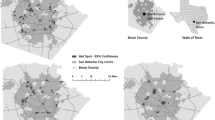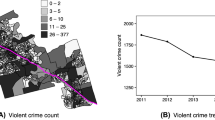Abstract
Objectives
We propose and test a multilevel theoretical model of crime concentration by combining criminal opportunity and social disorganization into a single hierarchical model. Our theoretical model simultaneously answers calls to integrate routine activities theory and social disorganization theory and provides a logical framework for understanding the connections between neighborhood context and micro-spatial environmental conditions.
Methods
To test our theory we used multilevel negative binomial regression with controls for spatial dependence to estimate street segment level crime counts.
Results
Findings showed the expected direct effects on street segment-level violent and property crime of both micro- and neighborhood-level characteristics. Our results for cross-level interaction effects provided evidence neighborhood context moderates the association between street segment-level variables and crime. Model comparisons using likelihood ratio tests revealed that including neighborhood-level characteristics improved explanatory power relative to single level models.
Conclusions
This study lends support to a multilevel theory of the law of crime concentration that includes both neighborhood and street segment level conditions.

Similar content being viewed by others
References
Aguinis H, Gottfredson RK, Culpepper SA (2013) Best-practice recommendations for estimating cross-level interaction effects using multilevel modeling. J Manag 39(6):1490–1528
Andresen MA, Malleson N (2011) Testing the stability of crime patterns: implications for theory and policy. J Res Crim Delinq 48(1):58–82
Barker RG (1968) Ecological psychology: concepts and methods for studying the environment of human behavior. Stanford University Press, Stanford
Beavon DJ, Brantingham PL, Brantingham PJ (1994) The influence of street networks on the patterning of property offenses. In: Clarke RV (ed) Crime prevention studies, vol 2. Criminal Justice Press, Monsey, pp 115–148
Bernasco W, Block R (2011) Robberies in Chicago: a block-level analysis of the influence of crime generators, crime attractors, and offender anchor points. J Res Crim Delinq 48(1):33–57
Bernasco W, Luykx F (2003) Effects of attractiveness, opportunity and accessibility to burglars on residential burglary rates of urban neighborhoods. Criminology 41(3):981–1002
Bottoms A (2017) Crime specifics, offender residences and social change: developing the criminology of place. Jerus Rev Legal Stud 15:1–11
Braga AA, Clarke RV (2014) Explaining high-risk concentrations of crime in the city: social disorganization, crime opportunities, and important next steps. J Res Crim Delinq 51(4):480–498
Brantingham PJ (2016) Crime diversity. Criminology 54(4):553–586
Brantingham PL, Brantingham PJ (1993) Nodes, paths and edges: considerations on the complexity of crime and the physical environment. J Environ Psychol 13(1):3–28
Brantingham PL, Brantingham PJ (1999) A theoretical model of crime hot spot generation. Stud Crime Crime Prev 8(1):7–26
Bursik RJ (1984) Urban dynamics and ecological studies of delinquency. Soc Forces 63(2):393–413
Clarke RV (1997) Situational crime prevention. Harrow and Heston, New York
Cohen LE, Felson M (1979) Social change and crime rate trends: a routine activity approach. Am Soc Rev 44(4):588–608
Curman AS, Andresen MA, Brantingham PJ (2015) Crime and place: a longitudinal examination of street segment patterns in Vancouver, BC. J Quant Criminol 31(1):127–147
Deryol R, Wilcox P, Logan M, Wooldredge J (2016) Crime places in context: an illustration of the multilevel nature of hot spot development. J Quant Criminol 32(2):305–325
Eck JE, Weisburd DL (2015) Crime places in crime theory. Crime Place Crime Prev Stud 4(1):1–33
Felson M, Clarke RV (1998) Opportunity makes the thief: practical theory for crime prevention. Police research series, paper 98. Home Office, London
Ford JM, Beveridge A (2004) “Bad” neighborhoods, fast food, “sleazy” businesses, and drug dealers: relations between the location of licit and illicit businesses in the urban environment. J Drug Issues 34(1):51–76
Groff E (2013) Measuring a place’s exposure to facilities using geoprocessing models: an illustration using drinking places and crime. In: Leitner M (ed) Crime modeling and mapping using geospatial technologies. Springer, New York, pp 269–295
Groff E, Lockwood B (2014) Criminogenic facilities and crime across street segments in Philadelphia uncovering evidence about the spatial extent of facility influence. J Res Crim Delinq 51(3):277–314
Groff E, McCord ES (2012) The role of neighborhood parks as crime generators. Secur J 25(1):1–24
Groff ER, Weisburd D, Yang SM (2010) Is it important to examine crime trends at a local “micro” level?: a longitudinal analysis of street to street variability in crime trajectories. J Quant Criminol 26(1):7–32
Grubesic TH, Murray AT, Pridemore WA, Tabb LP, Liu Y, Wei R (2012) Alcohol beverage control, privatization, and the geographic distribution of alcohol outlets. BMC Public Health 12(1):1015
Haberman C (2017) Overlapping hot spots? Criminol Public Policy 16(2):633–660
Jones RW (2013) UK area report: a report on crime, LexCall, code enforcement, and building inspection in UK area neighborhoods. Lexington-Fayette Urban County Government: Neighborhood Incident Management System (NIMS)
Kornhauser RR (1978) Social sources of delinquency: an appraisal of analytic models. University of Chicago Press, Chicago
Lentz TS (2018) Crime diversity: reexamining crime richness across spatial scales. J Contemp Crim. https://doi.org/10.1177/1043986218770002
Long JS (1997) Regression models for categorical and limited dependent variables. Sage, Thousand Oaks
Miethe TD, McDowall D (1993) Contextual effects in models of criminal victimization. Soc Forces 71(3):741–759
Miethe TD, Meier RF (1990) Opportunity, choice, and criminal victimization: a test of a theoretical model. J Res Crim Delinq 27(3):243–266
Morenoff JD, Sampson RJ, Raudenbush SW (2001) Neighborhood inequality, collective efficacy, and the spatial dynamics of urban violence. Criminology 39(3):517–558
Pridemore WA, Grubesic TH (2012) Community organization moderates the effect of alcohol outlet density on violence. Brit J Sociol 63(4):680–703
Ratcliffe JH, Taniguchi T, Taylor RB (2009) The crime reduction effects of public CCTV cameras: a multi-method spatial approach. Justice Q 26(4):746–770
Raudenbush SW, Bryk AS (2002) Hierarchical linear models: applications and data analysis methods. Sage, Thousand Oaks
Rengert G, Lockwood B (2009) Geographical units of analysis and the analysis of crime. In: Weisburd D, Bernasco W, Bruinsma G (eds) Putting crime in its place: units of analysis in spatial crime research. Springer, New York, pp 109–122
Rice KJ, Smith WR (2002) Socioecological models of automotive theft: integrating routine activity and social disorganization approaches. J Res Crim Delinq 39(3):304–336
Roncek DW (2000) Schools and crime. In: Goldsmith V, McGuire P, Mollenkopf JH, Ross TA (eds) Analyzing crime patterns: frontiers of practice. Sage Publications, Thousand Oaks, pp 153–165
Roncek DW, Faggiani D (1985) High schools and crime: a replication. The Soc Q 26(4):491–505
Roncek DW, LoBosco A (1983) The effect of high schools on crime in their neighborhoods. Soc Sci Q 64(3):598–613
Roncek DW, Maier PA (1991) Bars, blocks, and crimes revisited: linking the theory of routine activities to the empiricism of “hot spots”. Criminology 29(4):725–753
Rountree PW, Land KC, Miethe TD (1994) Macro-micro integration in the study of victimization: a hierarchical logistic model analysis across Seattle neighborhoods. Criminology 32(3):387–414
Sampson RJ (1988) Local friendship ties and community attachment in mass society: a multilevel systemic model. Am Sociol Rev 53(5):766–779
Sampson RJ (2012) Great American city: Chicago and the enduring neighborhood effect. University of Chicago Press, Chicago
Sampson RJ, Groves WB (1989) Community structure and crime: testing social-disorganization theory. Am J Sociol 94(4):774–802
Sampson RJ, Raudenbush SW, Earls F (1997) Neighborhoods and violent crime: a multilevel study of collective efficacy. Science 277(5328):918–924
Schnell C, Braga AA, Piza EL (2016) The influence of community areas, neighborhood clusters, and street segments on the spatial variability of violent crime in Chicago. J Quant Criminol 33:1–28. https://doi.org/10.1007/s10940-016-9313-x
Sherman LW, Gartin PR, Buerger ME (1989) Hot spots of predatory crime: routine activities and the criminology of place. Criminology 27(1):27–56
Smith DA, Jarjoura GR (1989) Household characteristics, neighborhood composition and victimization risk. Soc Forces 68(2):621–640
Smith WR, Frazee SG, Davison EL (2000) Furthering the integration of routine activity and social disorganization theories: small units of analysis and the study of street robbery as a diffusion process. Criminology 38(2):489–524
Steenbeek W, Weisburd D (2016) Where the action is in crime? An examination of variability of crime across different spatial units in The Hague, 2001–2009. J Quant Criminol 32(3):449–469
Taylor RB (1997) Social order and disorder of street blocks and neighborhoods: ecology, microecology, and the systemic model of social disorganization. J Res Crim Delinq 34(1):113–155
Thornberry T (1989) Reflections on the advantages and disadvantages of theoretical integration. In: Messner SF, Krohn D, Liska AE (eds) Theoretical integration in the study of deviance and crime: problems and prospects. SUNY Press, Albany, pp 51–60
Weisburd D (2012) Bringing social context back into the equation. Crim Pub Policy 11(2):317–326
Weisburd D (2015) The law of crime concentration and the criminology of place. Criminology 53(2):133–157
Weisburd D, Amram S (2014) The law of concentrations of crime at place: the case of Tel Aviv-Jaffa. Police Prac Res 15(2):101–114
Weisburd D, Green L (1994) Defining the street-level drug market. In: MacKenzie DL, Uchida CD (eds) Drugs and crime: evaluating public policy initiatives. Sage, Thousand Oaks, pp 61–76
Weisburd D, Bushway S, Lum C, Yang SM (2004) Trajectories of crime at places: a longitudinal study of street segments in the city of Seattle. Criminology 42(2):283–322
Weisburd D, Bruinsma GJ, Bernasco W (2009) Units of analysis in geographic criminology: historical development, critical issues, and open questions. In: Weisburd D, Bernasco W, Bruinsma GJ (eds) Putting crime in its place. Springer, New York, pp 3–31
Weisburd D, Groff ER, Yang SM (2012a) The criminology of place: street segments and our understanding of the crime problem. Oxford University Press, New York
Weisburd D, Lawton B, Ready J (2012b) Staking out the next generation of studies of the criminology of place: collecting prospective longitudinal data at crime hot spots. In: Lober R, Welsh BC (eds) The future of criminology. Oxford University Press, New York, pp 236–243
Weisburd D, Groff E, Yang SM (2017) The criminology of place: key contributions and commentary. Jerus Rev Legal Stud 15:61–76
Welsh BC, Farrington DP (2004) Surveillance for crime prevention in public space: results and policy choices in Britain and American. Criminol Pub Policy 3(3):497–526
Wicker AW (1987) Behavior settings reconsidered: temporal stages, resources, internal dynamics, context. In: Stokels D, Alman I (eds) Handbook of environmental psychology. Wiley-Interscience, New York, pp 613–653
Wilcox P, Land KC, Hunt SA (2003) Criminal circumstance: a dynamic multi-contextual criminal opportunity theory. Aldine de Gruyter, New York
Wilcox P, Gialopsos B, Land K (2013) Multilevel criminal opportunity. In: Cullen FT, Wilcox P (eds) The Oxford handbook of criminological theory. Oxford University Press, New York, pp 579–601
Wright RT, Decker S (1994) Burglars on the job. Northeastern University Press, Boston
Author information
Authors and Affiliations
Corresponding author
Rights and permissions
About this article
Cite this article
Jones, R.W., Pridemore, W.A. Toward an Integrated Multilevel Theory of Crime at Place: Routine Activities, Social Disorganization, and The Law of Crime Concentration. J Quant Criminol 35, 543–572 (2019). https://doi.org/10.1007/s10940-018-9397-6
Published:
Issue Date:
DOI: https://doi.org/10.1007/s10940-018-9397-6




